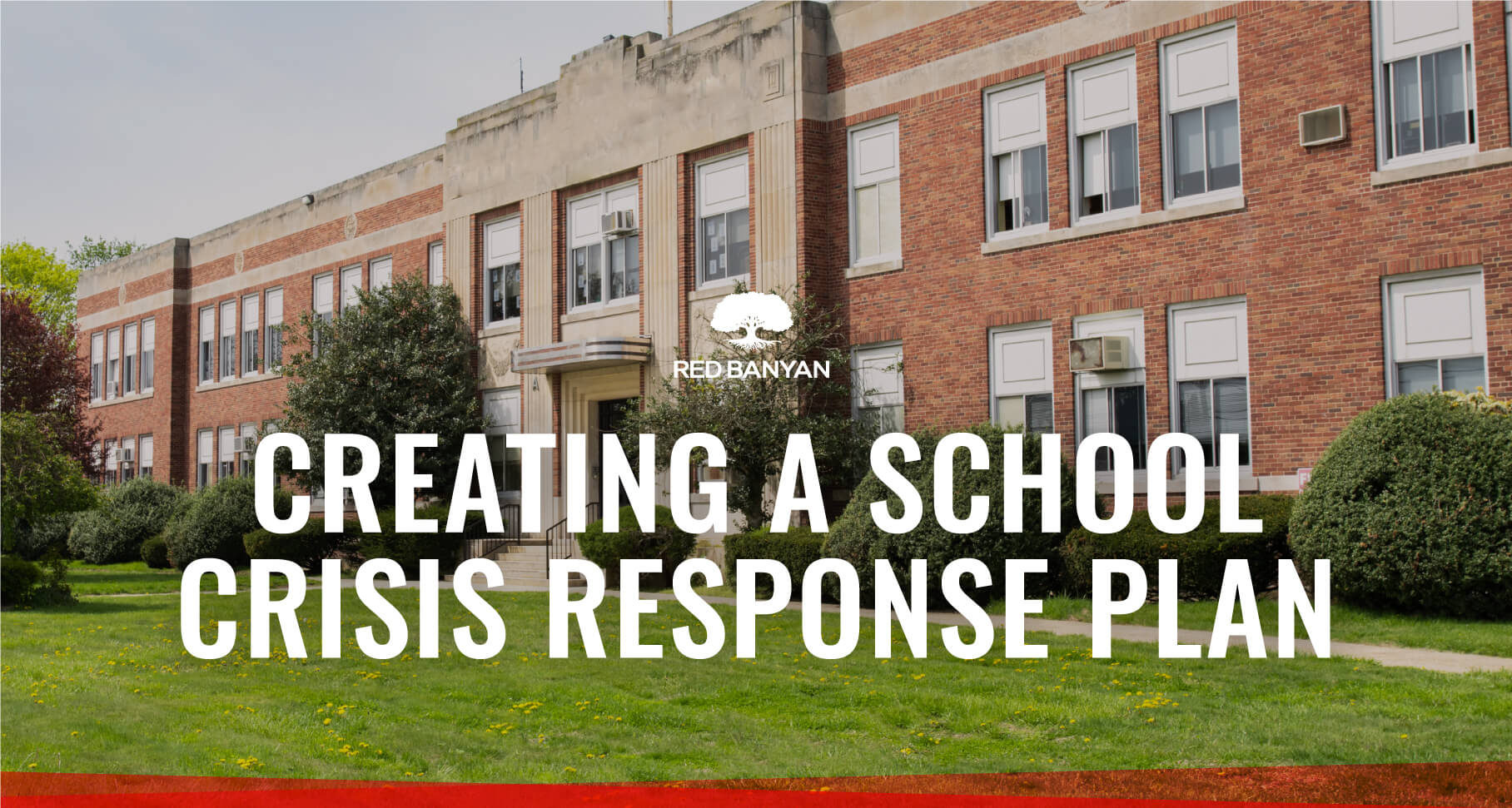How to Create a School Crisis Response Plan
October 11, 2022 | Category: Blog, Crisis PR, News, Public Relations, Social Media

Creating a school crisis response plan is essential to protecting students and teachers in case of an emergency. In an uncertain world, crisis planning has become a necessity to provide peace of mind for parents and other stakeholders whose loved ones work at schools or attend schools. Having a crisis communications plan before one is needed is the best time to outline crisis planning steps in order to think of all angles, and have a range of backup plans in place.
School crisis plans provide a roadmap that informs school personnel what to do in case of emergencies so they can implement the plan immediately to help avoid chaos. Teachers should have a checklist of actions to put into place if an intruder breaches school security and enters the premises, for example. No plan is foolproof, but having a prepared list of steps in place to safeguard employees will provide some peace of mind and help eliminate missteps that could save lives in a school crisis.
When an emergency happens, it can be easy to panic. That is why it is essential to have a written school crisis plan in place before an incident occurs. Employees who know what to do and have an action plan to follow may be able to minimize their exposure to the threat for the best outcome possible.
Crisis communications professionals like those at Red Banyan can help create a comprehensive school crisis plan that will take into consideration everything from the number of employees and students to the communications channels, available technology and existing training. Being ready with a comprehensive crisis plan is the best way to prepare for any kind of emergency.
Red Banyan’s strategic communications experts will conduct an audit of your organization to pinpoint strengths and weaknesses and discuss areas of concern with your staff. Our team of seasoned crisis PR experts will then outline a school crisis response plan with input from school personnel, so the end product provides a detailed roadmap of what to do should something take place on campus.
Why a Crisis Plan Checklist Matters
Managing a crisis is an important part of school safety that focuses on time-limited, problem-focused intervention. The goal of crisis management is to identify, confront and resolve the crisis, and then restore normalcy as quickly as possible. The goal is to protect the health and welfare of students and staff.
A thorough school crisis response plan is a prevention-focused plan that relies on a variety of strategies that include everything from building design to discipline policies to improve the overall atmosphere inside a school.
School crisis response plans should include plans for all critical incidents that can cause harm to students, staff and any other personnel. Situations that a crisis plan should address include natural disasters, fires, the use of weapons and the taking of hostages. The crisis PR professionals at Red Banyan can help create a comprehensive list of situations that a school should take into consideration.
Red Banyan’s team of school crisis PR experts will help your organization develop intervention procedures and give recommendations for how best to communicate in a crisis. In addition, experts from our award-winning crisis communications agency can assist school administrators with the establishment of crisis response procedures.
Crisis response procedures should include the following:
- Gathering information
- Establishing communication with families
- Disseminating accurate information to faculty and students
- Intervening with students most likely to be affected
- Increasing supportive counseling for students and staff
- Guiding students in helpful ways to move beyond trauma
Red Banyan’s crisis communications will outline a customized school crisis response that will provide an organized, systematic method for helping students in emergencies. Under the plan, crisis team members will help school personnel make collaborative decisions and share responsibility in situations that can be difficult, stressful and highly stressful. Our crisis PR experts will create a checklist of responsibilities that school personnel can refer to in time of need and rest easy that they have taken as many preliminary precautions as possible for the most favorable outcome.
Essential Elements of a School Crisis Plan
School crises plans should outline the responsibilities of every school employee from the principal or head of school down. The value of assigning roles is huge – when an emergency occurs, everyone knows what to do and can spring into action without requiring directions.
Having a crisis plan in place can also help reduce a school’s liability as far as preparing for the unexpected and having in place an action plan to safeguard employees and potentially save lives. Solid preparation and in-depth planning and consultation in collaboration with security experts and law enforcement is key to providing the best protection possible. Unfortunately, the need for school crisis response planning continues to grow in the United States. School personnel needs to have as many available tools on hand to combat threats to staff and students.
Schools also need established crisis response plans so that administrators can assure worried parents that the school is prepared when it comes to disaster response. Schools also need to create policies and procedures to facilitate interventions for troubled students and improve schools’ overall crisis response.
Here are some basic elements of a school crisis response plan:
- Institute a phone tree to disseminate information to Crisis Response Team members
- Identify parties affected by the crisis
- Notify staff or families of affected parties and recommend community resources for support, as appropriate.
- Keep all faculty and parents updated in a timely manner
- Be alert for long-term effects on among students and staff
- Amend crisis response procedures as necessary
School crisis response procedures will help guide staff in responding to crises and other traumatic events, which can affect the school community for days. These procedures are intended to be time-limited, problem-focused interventions designed to identify and resolve the crisis and restore balance.
Unexpected events such as suicides, school bus crashes, natural disasters, active shooters, or other scenarios resulting in injury or death can quickly escalate into catastrophes if not addressed immediately and effectively. Having a plan that outlines what to do should a crisis occur will minimize the chaos, rumors, and the impact of the event on the other students.
Elements of a Sample School Crisis Plan
Effective communication on all levels is essential for a school crisis response plan. Crisis communications experts like those at Red Banyan are available to review a school’s existing crisis PR plan, identify the weaknesses and strengths, and suggest improvements where needed.
Red Banyan’s media relations and strategic communications professionals will help you create a media outreach plan that will work hand-in-hand with your organization’s overall crisis PR plan. Good communication is mandatory in a crisis and can make or break an organization’s ability to weather a crisis and come out satisfactorily on the other side.
Have you chosen a director of community relations or a company spokesperson? Naming one person as your organization’s media liaison is important for a variety of reasons. Having a single spokesperson allows an organization to best control the narrative and what information is being released. This is important because incorrect information is often released to the public in the heat of a disaster, and then extra efforts must be made to correct statements and reissue press releases. Meanwhile, trust has been shattered. Sharing inaccurate information only serves to make a crisis situation more stressful and undermine the school and its leadership.
Here are 10 key points:

Share information with the media, but make sure it is accurate. Be aware of deadlines.

Plan and coordinate interviews with reporters in coordination with their deadlines.

Create and disseminate press releases.

Share updates on social media. Monitor social media accounts and respond to questions.

Create a comprehensive press list and keep it updated.

Quash rumors that are false and provide correct information.

Utilize the local cable television networks to provide updates.

Coordinate information to be shared with school personnel during and after the crisis.

Coordinate media interviews with key school officials if necessary.

Establish a clearinghouse for calls and requests from schools, parents and the community.
Make Improvements to your Crisis Plan and Provide Training
Good planning can always be made better, so it is important to continually reassess and re-evaluate. Review your protocols and look for any weaknesses. Then figure out ways to eliminate any gaps.
Developing relationships with law enforcement, fire departments and community leaders is important for support, prevention and recovery. Knowing who to call when something seems suspicious, goes wrong and needs to be improved can be lifesaving.
Frequently Asked Questions – School Crisis Response Plan:
- What are three things that should be considered in a school crisis response plan? When you create a school crisis response plan, make sure to align the crisis communications plan with the operational plan. The reason? A review of current policies, operations and emergencies plans will quickly reveal if the two conflict. Conflicts could cause confusion during a crisis and lead to mistakes.
- Why should you assign crisis response team members specific roles and know how to reach them? Confusion reigns during an emergency so it is essential to know who is assigned to what job ahead of time and have a plan for how to reach them. What will you do if cell phone service is interrupted? Having a plan in place will also include backup plans.
- How can you build risk into your crisis plan? In order to build risk into your crisis plan, you have to know ahead of time what those risks may be. Outline the risks, and then come up with ways to avoid and overcome them. Also include a plan that details what you will do should a risk become reality.
Red Banyan’s team of school crisis response plan experts can help your organization create an effective crisis plan that is tailored to your school’s special needs. Having a crisis plan in place before a disaster occurs is the key to surviving and thriving. Contact Red Banyan to find out how we can help.

